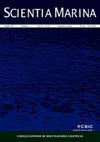大西洋东北部一种正在扩张的物种——大西洋斑鱼(Scomber colias)生活史参数的空间变异性
IF 0.9
4区 生物学
Q4 MARINE & FRESHWATER BIOLOGY
引用次数: 0
摘要
大西洋鲢鱼是大西洋中的一种中上层物种,近几十年来在东大西洋向北扩展。2011年至2019年间,在科学调查和商业捕捞中收集了鱼类样本。我们分析了五个地理区域(从南到北)的生物参数(年龄、长度、重量和条件)的地理变化,以及长重关系、长度成熟度和产卵季节的开始和持续时间:加那利群岛、加的斯湾、葡萄牙西海岸、西班牙西北海岸和坎塔布里安海。海面温度(SST)对鱼类长度的影响被建模为地理变异的潜在驱动因素。从加那利群岛的1月到坎塔布里亚海的5月至8月,当SST在15°C至19°C之间时,所有生物参数都向北逐渐增加,而产卵季节随着纬度的增加而推迟和延长。SST在三个研究区域对长度有积极影响,在其中两个研究区域中对长度有消极影响,这表明每组在其热耐受范围内处于不同的位置。与加的斯湾一些生物参数的地理模式的偏差表明,它可能是大西洋-非洲、地中海和大西洋-伊比利亚人口组成部分之间的枢纽或混合区。本文章由计算机程序翻译,如有差异,请以英文原文为准。
Spatial variability of life-history parameters of the Atlantic chub mackerel (Scomber colias), an expanding species in the northeast Atlantic
Atlantic chub mackerel is a pelagic species present in the Atlantic Ocean that in recent decades has expanded northwards in the eastern Atlantic. Fish samples were collected in scientific surveys and commercial catches between 2011 and 2019. We analysed the geographical variation of the biological parameters (age, length, weight and condition), as well as the length-weight relationship, maturity-at-length and spawning season onset and duration in five geographical areas (from south to north): the Canary Islands, Gulf of Cadiz, western Portuguese coast, northwestern Spanish coast and Cantabrian Sea. The influence of sea surface temperature (SST) on fish length was modelled as a potential driver of geographical variability. All biological parameters increased progressively northwards, while the spawning season was delayed and prolonged with increasing latitude, from January in the Canary Islands to May-August in the Cantabrian Sea, when SST was between 15°C and 19°C. SST had a positive effect on length in three study areas and a negative one in two of them, suggesting that each group is at a different position within their thermal tolerance range. Deviance from the geographical pattern of some biological parameters in the Gulf of Cadiz suggests that it could be a hinge or mixing zone between Atlantic African, Mediterranean and Atlantic Iberian population components.
求助全文
通过发布文献求助,成功后即可免费获取论文全文。
去求助
来源期刊

Scientia Marina
生物-海洋与淡水生物学
CiteScore
2.10
自引率
0.00%
发文量
21
审稿时长
6-12 weeks
期刊介绍:
Scientia Marina is the successor to Investigación Pesquera, a journal of marine sciences published since 1955 by the Institut de Ciències del Mar de Barcelona (CSIC). Scientia Marina is included in the Science Citation Index since 1998 and publishes original papers, reviews and comments concerning research in the following fields: Marine Biology and Ecology, Fisheries and Fisheries Ecology, Systematics, Faunistics and Marine Biogeography, Physical Oceanography, Chemical Oceanography, and Marine Geology. Emphasis is placed on articles of an interdisciplinary nature and of general interest.
 求助内容:
求助内容: 应助结果提醒方式:
应助结果提醒方式:


